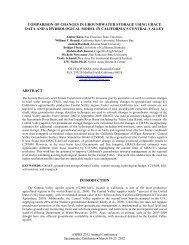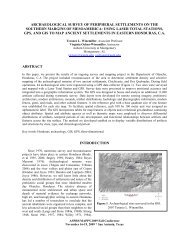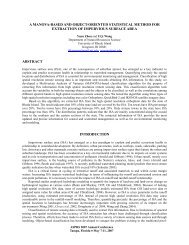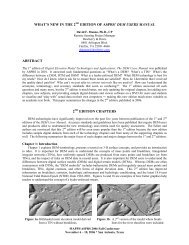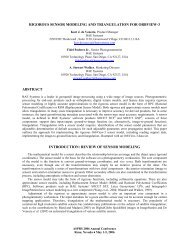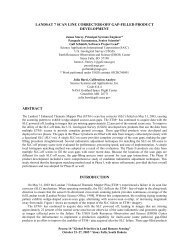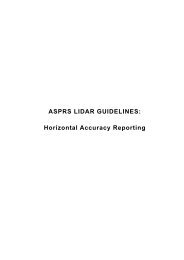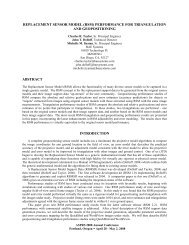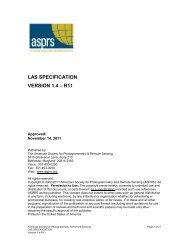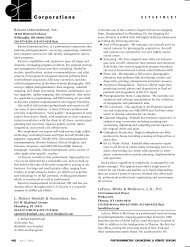using image fusion and classification to profile a human ... - asprs
using image fusion and classification to profile a human ... - asprs
using image fusion and classification to profile a human ... - asprs
You also want an ePaper? Increase the reach of your titles
YUMPU automatically turns print PDFs into web optimized ePapers that Google loves.
the main highways. One can infer that the roads play an important role for the livelihood of the people because of<br />
the amount of agriculture <strong>and</strong> the need <strong>to</strong> get farming supplies/equipment in <strong>and</strong> crop yield out <strong>to</strong> sell.<br />
Vegetation. The vegetation in this region consists of trees <strong>and</strong> ground cover bush that are growing around wet<br />
areas, higher altitude mountainous or hilly areas, <strong>and</strong> the settlements. The mountainous areas are fully vegetated<br />
while the lower flat areas are mostly open <strong>and</strong> being used for agriculture purposes, indicating again how important<br />
the agricultural industry is for these people. The creeks <strong>and</strong> rivers that feed the irrigation ditches are vegetated <strong>and</strong><br />
help visualize the path of the river across the region. Another interesting phenomenon of the vegetation in this<br />
region is that it grows around the settlements, or, the settlements were built <strong>to</strong> coincide with the vegetated areas.<br />
This is most likely because vegetation provides a natural shelter from strong wind, s<strong>and</strong> s<strong>to</strong>rms, rain, <strong>and</strong> offers<br />
shade from the sun.<br />
Water wells. Most of the neighborhoods contain water wells that are close <strong>to</strong> the settlement structures. The<br />
average size is approximately 60 meters in diameter <strong>and</strong> there is usually one for each neighborhood area. The<br />
roadways <strong>to</strong> <strong>and</strong> from these wells appear <strong>to</strong> be in constant use, as evidenced by the fresh dirt on the road surface.<br />
The presence of wells most likely indicates the lack of a sophisticated plumbing infrastructure, as is the case in more<br />
rural <strong>and</strong> un-developed areas.<br />
Settlements. The settlements structures in this region are long <strong>and</strong> wide, averaging approximately 5 meters<br />
wide by 15 meters long, <strong>and</strong> built very close <strong>to</strong>gether. These settlements contains a long structure parallel with the<br />
road <strong>and</strong> many long skinny structures built behind it that are perpendicular <strong>to</strong> the road, most likely, the front is a<br />
common area <strong>and</strong> the back are more private family areas. The settlement is laid out either side <strong>and</strong> very close <strong>to</strong> the<br />
roadway, indicating the road is of high importance <strong>and</strong> a main focus in servicing this settlement. Most likely, the<br />
road provides a means for survival <strong>to</strong> this village, servicing the agriculture needs, export/selling agricultural yields,<br />
providing access <strong>to</strong> medicine <strong>and</strong> medical care, <strong>and</strong> allowing people <strong>to</strong> procure other modern conveniences. The<br />
footprint of the settlement on the ground looks <strong>to</strong> be minimized <strong>to</strong> service the agriculture industry, which is<br />
indicated by the agriculture fields being built right up <strong>to</strong> <strong>and</strong> around the settlement. Also, the residents of the village<br />
are probably the ones that farm the fields since there is no separation between the village <strong>and</strong> the fields. The<br />
settlement is fairly isolated with the closest neighbor being a small village about 1 km east <strong>and</strong> the closest small city,<br />
Ch<strong>and</strong>pur, being approximately 9 km southeast.<br />
Population. According <strong>to</strong> the 2001 country census, India’s Nayagarh district has a <strong>to</strong>tal population of 132,644<br />
people with 69,115 being men <strong>and</strong> 63,529 women. In addition <strong>to</strong> the general population the State of Orissa<br />
recognizes two other <strong>classification</strong>s of people, scheduled casts <strong>and</strong> scheduled tribes. Scheduled casts make up<br />
14,960 people <strong>to</strong>tal with 7598 men <strong>and</strong> 7362 women. The scheduled tribes make up a much smaller population with<br />
621 <strong>to</strong>tal people with 325 men <strong>and</strong> 296 women. The working population was also captured in the census <strong>and</strong><br />
consists of 40,230 <strong>to</strong>tal workers with 36,993 men <strong>and</strong> 3,237 women. The non-working population is 92,414 <strong>to</strong>tal<br />
people with 32,122 men <strong>and</strong> 60,292 women, (India Census, 2001).<br />
Food. Cooked rice with dal <strong>and</strong> curry are the main meal for most of the people in the State of Orissa. Even the<br />
tribal people in the hilly regions who take millet <strong>and</strong> ragi as their staple food prefer a rice meal. In the more urban<br />
areas of the state some people have switched over <strong>to</strong> wheat in place of rice <strong>and</strong> use roti <strong>and</strong> chapati for cooking<br />
dinner. Rice as the main course can be prepared in a number of ways; the most common is with kanika which is<br />
cooked with ghee, sugar, <strong>and</strong> khechudi (State of Orissa/Food, Supplies, <strong>and</strong> Consumer Welfare, 2010).<br />
Language. Oriya is the mother <strong>to</strong>ngue of the people of Orissa <strong>and</strong> most of them underst<strong>and</strong> Hindi as well.<br />
People can sometimes speak Bengali, Telugu, Urdu <strong>and</strong> a bit of Gujarati in addition <strong>to</strong> the various tribal dialects.<br />
English can only be unders<strong>to</strong>od by the educated masses (State of Orissa/Government Portal, 2010).<br />
Religion. Of all of the states of India, Orissa has perhaps the highest concentration of Hindus. In 1971 the<br />
Hindus formed 92 per cent of the <strong>to</strong>tal population; the Muslims, Christians <strong>and</strong> Buddhists formed 1.5, 1.7 <strong>and</strong>. 04<br />
per cent respectively. The balance is primarily tribal religions of Sarana <strong>and</strong> Santals. Orissa is a l<strong>and</strong> of religious<br />
<strong>to</strong>lerance <strong>and</strong> the people belonging <strong>to</strong> different religions <strong>and</strong> faiths live harmoniously, often within the same village<br />
(State of Orissa/Government Portal, 2010).<br />
Industry. Industry also plays a key role in the economy. Products manufactured in Orissa include textiles,<br />
paper, leather goods, cement, soap, glass, aluminum, <strong>and</strong> flour. Some of the natural resources that are mined are<br />
iron, coal, <strong>and</strong> zinc. Orissa has trade relations with other states in India, the United States, Japan, Britain, <strong>and</strong><br />
Germany. There are many products that are shipped in <strong>and</strong> out of Orissa annually with the main exports being<br />
expensive gems, fish, fancy jewelry, baskets, <strong>and</strong> clothing. Orissa is known worldwide for its fine cloths <strong>and</strong> the<br />
painstaking effort with which they are made (State of Orissa/Industries, 2010).<br />
Pecora 18 –Forty Years of Earth Observation...Underst<strong>and</strong>ing a Changing World November 14 – 17,<br />
2011Herndon, Virginia



